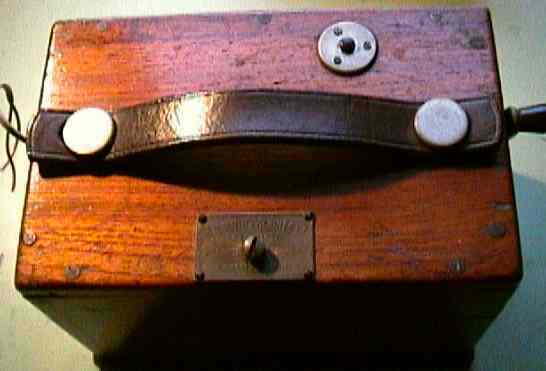

Evershed and Vignoles Hand Generator s/n 24798 Polished two part wooden box 5.5" x 8.5" x 6" high with leather carrying handle and fold away crank handle. Handle geared to 8 pole generator comprising horse shoe magnets, armature and brass ring commutator. Interior coiled spring return for 2 core output lead.The 200 volt output is obtained from the two lower outside brass wheel collectors shown in the picture below. The reel mechanism needs attention. London, after 1900 UK
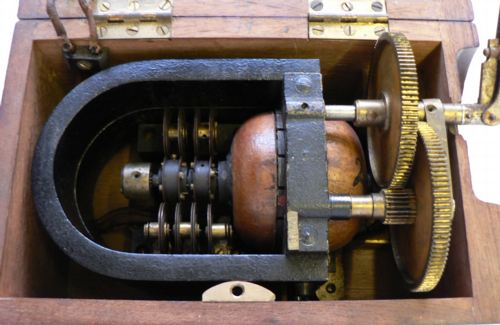
Evershed's 1900 pattern portable generator
Jon Clafton who has a 200V generator (serial number 17465) identical to mine sent me a picture of the cable reeling mechanism on his generator and the cable connector which is designed to work with the ohmmeter he also owns. He also has another generator (serial number 18550), similar to the 200V one, but that one simply has two output terminals
This is generator would probably have formed part of Evershed's Patent Testing Set (1900 pattern). This model superseded the 1895 model and preceded the new model introduced in 1904 which had the meter and the generator in one box. The generators were also made for firing electric fuses. You can read the Evershed and Vignoles publicity material describing the 'new' 1900 pattern testing set of the time here.
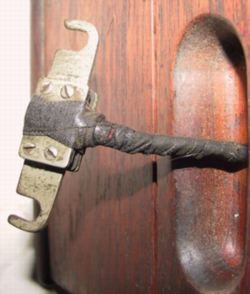
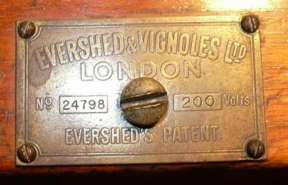
Clive Jackson has provided a description and pictures of a similar but smaller item used to test cable insulation. It measures 7" tall and is 6 1/2" by 6 1/2" in plan and also is housed in a polished wooden box with leather handle. Inside the door there is a fixed piece of card (Unfortunately a corner was torn off by his children some years ago) giving technical specifications and instructions. Evershed and Vignoles relocated their works to Acton Lane in 1903, so although this is a 1895 pattern it must have been made after that date.
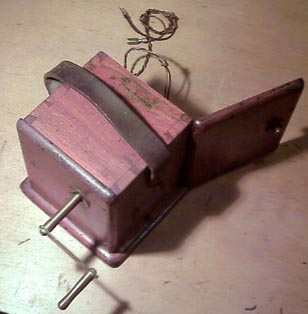
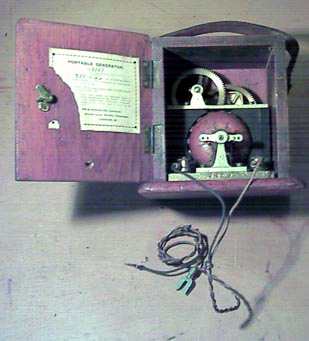
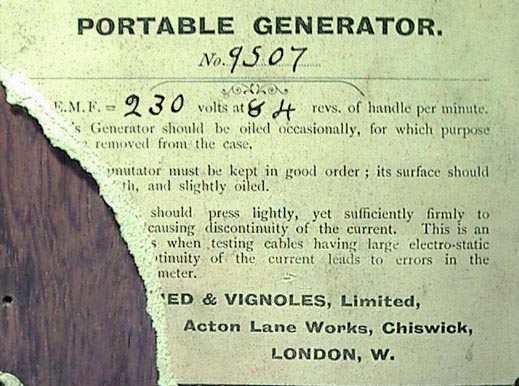
Evershed's 1895 pattern portable generator.
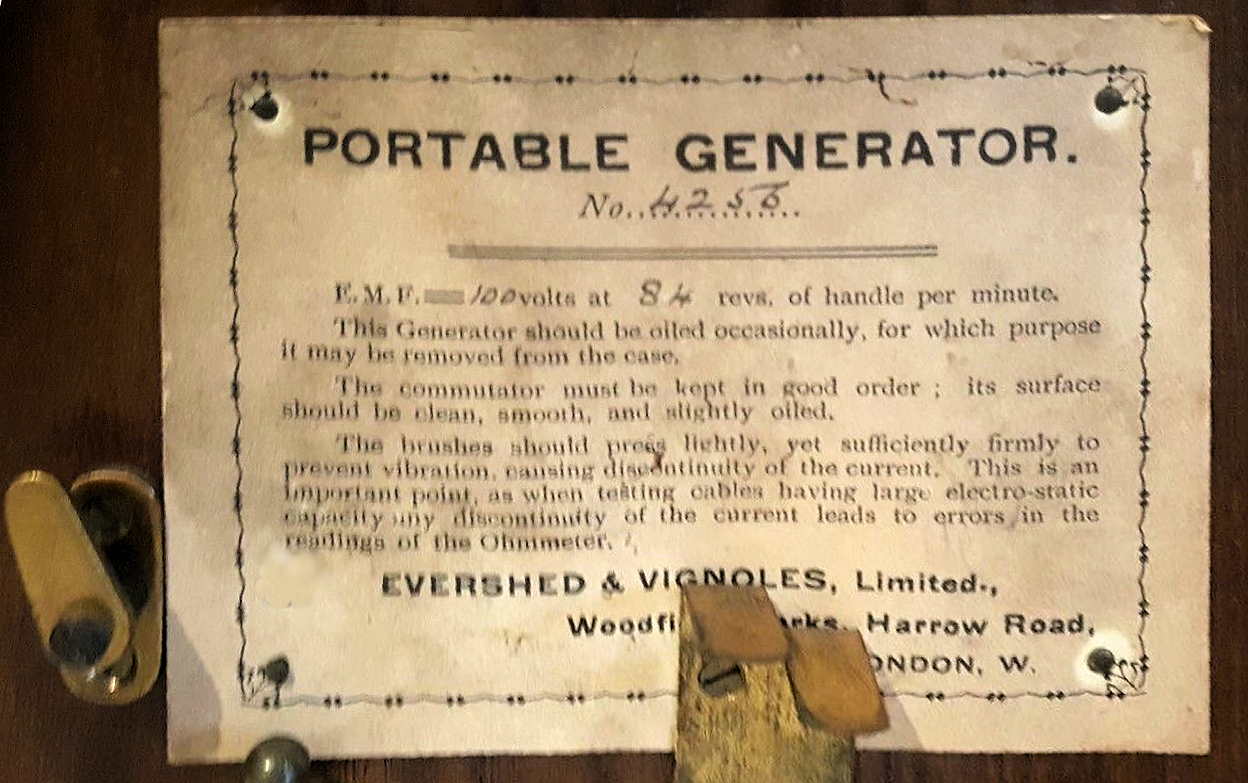
A complete label from an earlier portable generator made prior to 1903 at the Woodfield Works on Harrow Road
The intended use for Clive Jackson's generator shown above is shown and described in "Instruments of Science: An Historical Encyclopedia" by Robert Bud and Deborah Warner (01 December, 1997) - Garland.
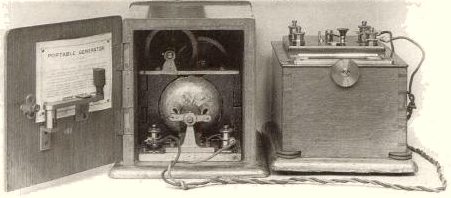
The generator was originally designed by a Mr Goolden of Messrs. Easton, Anderson & Goolden and the generator was used separately from the instrument itself to obviate interference by the permanent magnet fields of the generator. Evershed Vignoles then took over the manufacture. On p.89 of Sir David Salomans' book, 'Electric Light Installations, Part 3' published in 1894 there is a picture of such an instrument and its hand generator connected by 'curly' single conductors rather than the self-coiling cable reel which my item has.
I have "Direct Current Electrical Engineering" by JR Barr published by Pitman 1908 Which describes "..........Sidney Evershed's ohmmeter or 'Megger'...." This is a combined instrument, the generator and the meter sharing the same magnetic field. Although there is no picture of the construction this would seem to refer to the model first made in 1904.
Francois was searching information on the web about a hand generator when he came across this page and found that he had one which was very similar. The label on his reads: "Evershed & Vignoles Ltd., London, No. 12867, Patent, 200 volts, 100 revs".
His has no reeling mechanism in the top of the box. He found his in an antiques shop in Alston, 25 km south west of Hexham in Northumberland. There are many former lead mines in this area and he wonders if it could have been built as a generator for detonators. Pictures of his generator are shown below:
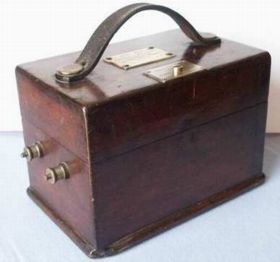
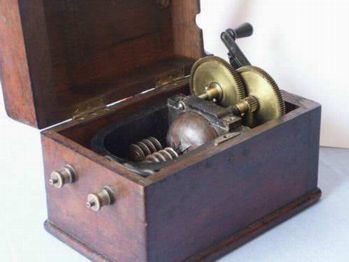
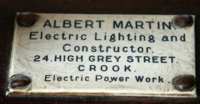
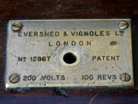
There are several Villages /Towns called Crook, but Crook, County Durham has a Grey Street and is not too far from the lead mining area in Northumberland. Martin is quite a common name in the North East of England.
Jon Clafton has a 200V generator (serial number 17465)
identical to mine. The rotary flex 'dispenser' is in perfect
condition and the entire device works perfectly.His still has the
original cable and fitted connectors. He also has another generator
(serial number 18550), similar to the 200V one, but that one simply
has two output terminals, and is 20V. He also has four Evershed
& Vignoles megger insulation testers similar to the one
featured below. These all have the original date on the underside
of the lid. The oldest one he has is dated 1912, and the newest is
dated 1920.
Jon Clafton's old generator and an accompanying
ohmmeter are shown below. He thinks the generator was made in the late
1890s and the ohmmeter the early 1900s.
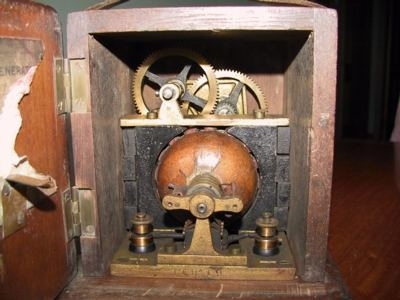
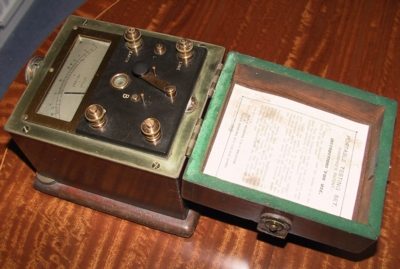
These are the instructions printed on the lid of the above meter.
PORTABLE TESTING SET
EVERSHED'S PATENT
INSTRUCTIONS FOR USE.
Adjust the Ohmmeter until the bubble is
in the centre of the spirit level.
Place the generator not less than 18 inches away from the Ohmmeter and
couple its terminals to the terminals G1 G on the Ohmmeter.
Couple the mains to be tested to the "LINE" and "EARTH" terminals of
the Ohmmeter. Turn the Generator handle steadily in either direction at
any speed above 110 revolutions per minute, and the Ohmmeter index will
point to the resistance under test.
When making tests in the neighbourhood of dynamos and generally when
very accurate results are required two observations should be made,
first when the generator is revolving in one direction and then in the
other. The mean of the two readings so obtained gives the value of the
resistance under test.
Jack Davidson.C.Eng. FIEE. advised that the famous brand name dates back to 1904, when the first portable insulation tester was introduced with the MEGGER brand name on it. This would have been similar to the one shown here:
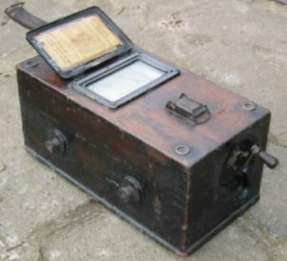
Simon Eastwood sent me pictures of his very similar generator generator which is made by Everett Edgecumbe. This is also a 200 volt model serial number 8145. Everett joined Edgecumbe in 1900 so this generator would have been manufactured after this date. see: http://www.museumoftechnology.com/cic.html
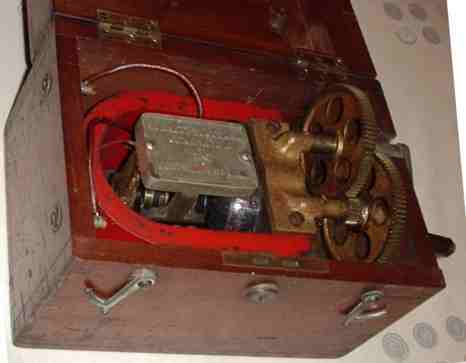
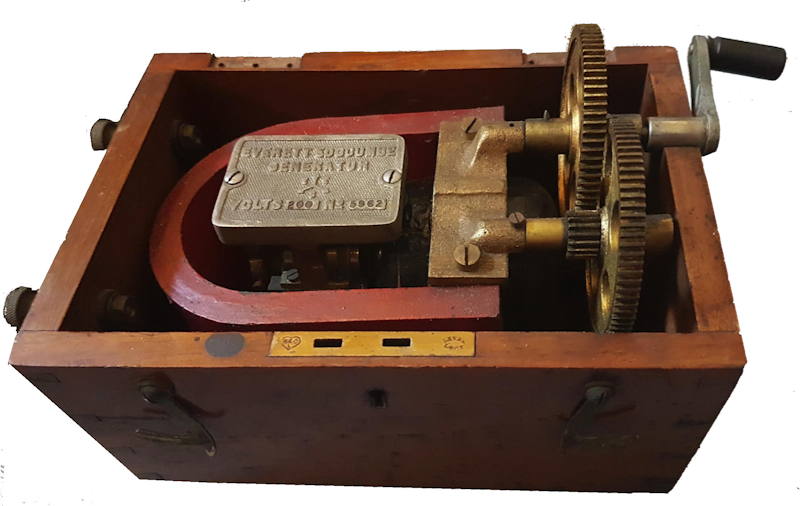
William Edward Ayrton (1847 - 1908) English engineer and inventor, with his colleague John Perry (1850 - 1920) invented many electrical measuring instruments and coined the the words 'voltmeter and ammeter'. In these, use was made of an ingeniously devised flat spiral spring (as used in modern analogue meters) which yields a relatively large rotation for a small axial elongation.
They also invented the principle of moving a pointer by the combined fields of separate voltage and current coils thus enabling power or resistance measurements to be made with only one instrument. They used fixed coils at right angles to each other and there was a magnetised needle at the pivot end of the pointer. There was no problem with coil connections since they were fixed and then as now, there was no control spring. The needle doesn't come to zero until the test terminals are shorted and the generator operated.
Evershed & Vignoles tidied things up. They made a double moving coil,one for voltage and one for current. They were fixed together, but not at right angles. The pointer was fixed to the coil assembly and the coil connections were ligaments, no hairsprings since the only influence on the coils was that of a powerful permanent magnet. This got over the gradual loss of magnetisation which the Ayrton and Perry instrument suffered from. It also enabled the generator and meter to be combined into one instrument as it was no longer necessary to obviate interference from the permanent magnet field of the generator.
The earlier instruments had two massive bar magnets with pole pieces at both ends, so that one end did for the moving coils and the other provided the generator field.These two pictures from Jon Clafton show the general construction and the second the generator without magnets and meter movement.
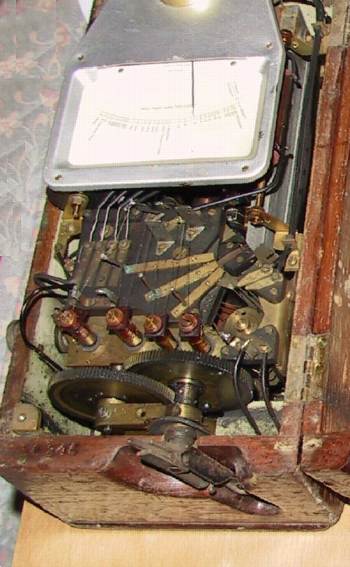
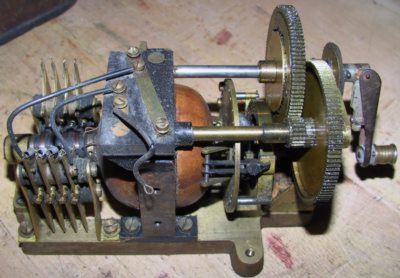
Interior
of 1904 pattern insulation tester and generator without magnet
Evershed's patent. The answer to much of the
speculation above is revealed in the US patent 639849 a small part of
which is reproduced here.
"Be it known that I, SYDNEY EVERSHED, a subject of the Queen of
Great
Britain and Ireland, residing at London, England, have invented a new
and useful Improvement in Portable Hand-Dynamos, (for which I have made
application for Letters Patent in Great Britain under No. 1,758,
bearing date January 25, 1899,) of which the following is a
specification.
This invention relates to portable hand dynamos, such as are used for
testing
purposes or for firing electric fuses or the like purposes,
where a small current t of high electromotive force can be utilised;
and it consists in an improvement whereby the frictional resistance to
rotation (of importance in such small appliances) is reduced to a
minimum both in the armature-bearings and in the commutator, the
current is collected with highest electromotive force, the hand 'which
is made collapsible when not in use and is then in a protected
position, and connection to any instrument or object, at a reasonable
distance from the generator, is rendered easy and rapid without the use
of loose wires, which may be mislaid, and without any binding-screws
projecting from the portable box containing the dynamo.
Figure 1 is a plan of
the
box, with
the lid open, containing the dynamo in the body of the box and the
winch-handle ready for operation issuing therefrom and the connection
device in the inside of the lid."
If you wand to read more and to view other patents try this link www.google.com/patents
Evershed & Vignoles Ltd., Acton Lane Works,Chiswick co-founded by Sydney Evershed (1857 -1939) in 1985 was taken over by AVO Ltd. Avocet House, 92-96 Vauxhall Bridge Road, London, SW1. AVO was a member of the Metal Industries Group of companies. Though known for their Avometer general purpose multimeter see here, they made a wide range of test gear including valve testers. The Acton Lane works closed down at about that time - around 1986. The current range of products can bee seen at: http://www.avointl.com/
The firm Megger Ltd. https://uk.megger.com is now based at: Archcliffe Road, Dover, Kent, CT17 9EN, United Kingdom.
Sources and acknowledgements
Many people have contacted me with photographs and details of
their instruments including:
Jon Clafton, Clive Jackson, Francois, Simon Eastwood, Craig Douglas
Tony West, Angus Jamieson, Selyem Toth Sandor, Adam Ward
For theory of operation see:
Electrical Measurements & Measuring
Instruments by Golding published by Pitman 1935. [page305 et seq]
Telephony Volume 1 by Atkinson published by Pitman 1948.
[page463 et seq.]
For the history of the firm I have used various sources on the internet
including:
[http://www.avo.co.nz/news/megger-application-news/193-electrical-tester-march-2010-from-megger]
[http://ecmweb.com/mag/electric_insulation_resistance_testing_3/]
[http://www.gracesguide.co.uk/]
C M Deavin for a wealth of information based on copies of
original Evershed and Vignoles documentation provided by Marion Heard,
the publicity assistant at Megger back in 2003.

